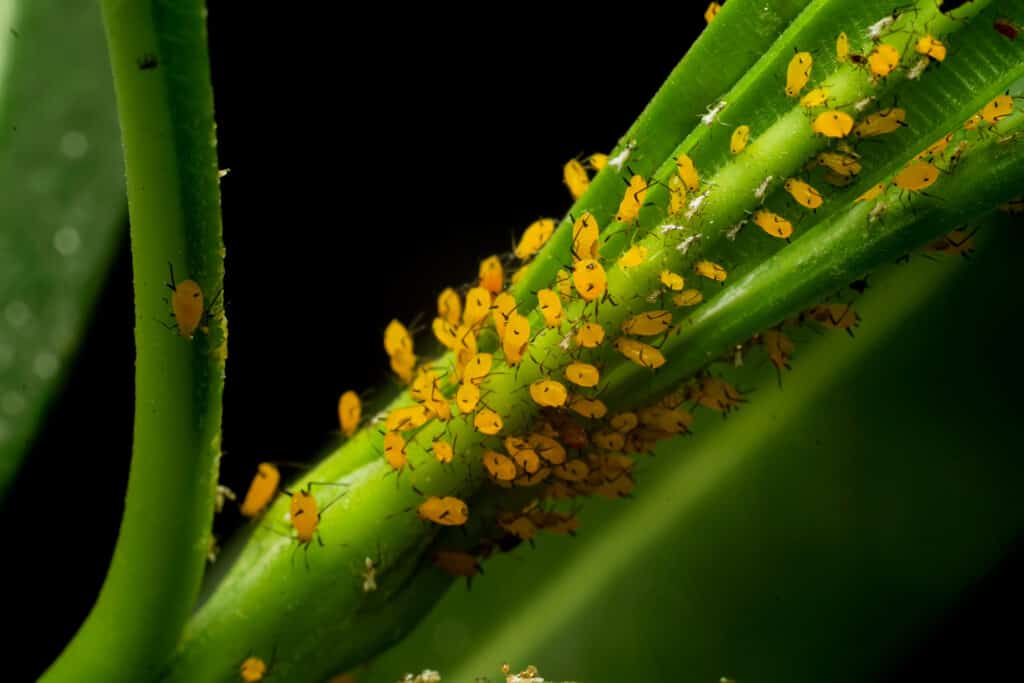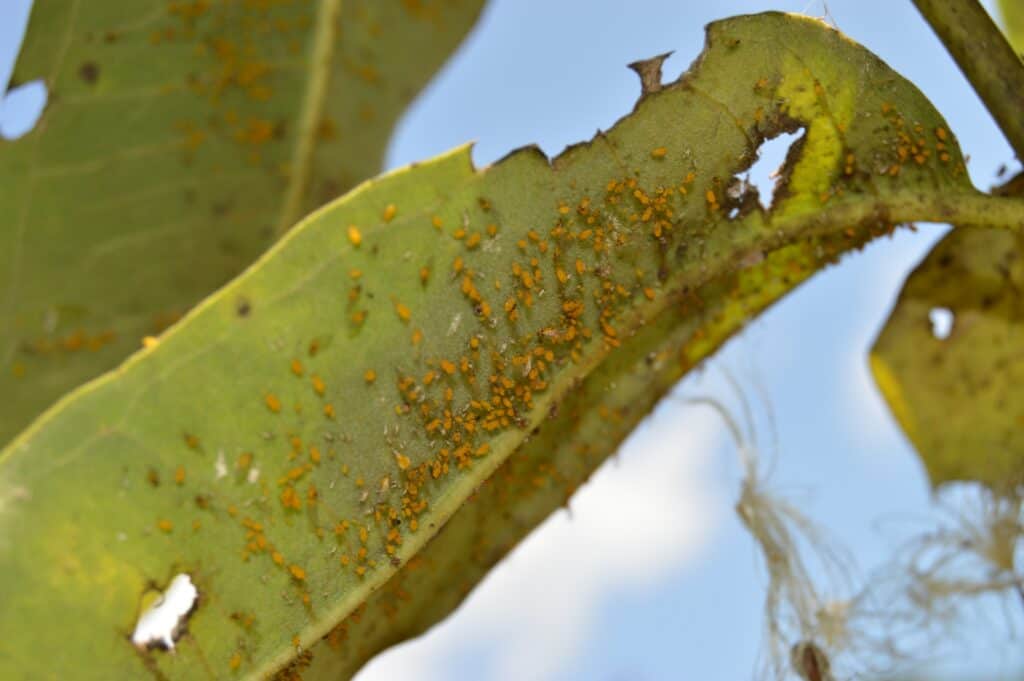Milkweed aphids
Aphis nerii
Can reproduce asexually
Advertisement
Milkweed aphids Scientific Classification
- Kingdom
- Animalia
- Phylum
- Arthropoda
- Class
- Insecta
- Order
- Hemiptera
- Family
- Aphididae
- Genus
- Aphis
- Scientific Name
- Aphis nerii
Read our Complete Guide to Classification of Animals.
Milkweed aphids Conservation Status

Milkweed aphids Facts
- Name Of Young
- larvae
- Group Behavior
- Group
- Fun Fact
- Can reproduce asexually
- Biggest Threat
- Predators
- Most Distinctive Feature
- Lacey wings
- Distinctive Feature
- Spongy mouthparts
- Other Name(s)
- Oleander aphid
- Habitat
- Tropical and Mediterranean climates
- Predators
- Lacewings, ladybugs, hoverflies, wasps
- Diet
- Herbivore
- Lifestyle
- Diurnal
- Favorite Food
- Sap from plants in dogbane family
- Number Of Species
- -2
- Location
- Worldwide
- Migratory
- 1
Milkweed aphids Physical Characteristics
- Color
- Yellow
- Black
- Skin Type
- Exoskeleton
- Length
- 1.5 to 2.6 millimeters
- Venomous
- No
- Aggression
- Low
View all of the Milkweed aphids images!
Aphis nerii is better known as the milkweed aphid. Other common names for this small, sap-sucking insect include the oleander aphid, sweet pepper aphid, and Nerium aphid. You can find milkweed aphids in tropical regions worldwide, as well as areas with a Mediterranean climate. Unlike some aphids, the milkweed aphid likely ranks as an obligate parthenogenetic species. This means all adult milkweed aphids are likely female, and no male milkweed aphids exist in the wild. Milkweed aphids act as vectors for several plant-borne diseases and can severely damage milkweed and oleander plants.
5 Milkweed Aphid Facts
- Milkweed aphids mostly feed on plants in the dogbane family, including milkweed, oleander, and periwinkle.
- Some scientists believe that milkweed aphids appear yellow as a warning sign to potential predators that the aphids are toxic.
- Milkweed aphids can tolerate and process the toxins produced by milkweed plants.
- Generally speaking, milkweed aphids prefer plants that have been fertilized, as they are attracted to plants with higher nitrogen content.
- Milkweed aphids parasitized by wasps leave behind swollen, brown, papery “mummies” once the parasitic host consumes and emerges from the aphid’s body.

While yellow aphids are not social insects, they are very rarely found alone.
©Goodly Pixels/Shutterstock.com
Species, Types, and Scientific Name
Like all aphids, milkweed aphids belong to the true bug order Hemiptera. They are members of the aphid family Aphididae, which contains over 5,000 known species. The origins of the term “aphid” remain shrouded in mystery. According to one theory, the Swedish botanist and zoologist Carl Linnaeus derived the term “aphid” from the Greek word apheides. Apheides translates roughly to “unsparing” or “lavishly bestowed.” The theory goes that Linnaeus chose this name in honor of the high reproductive rate of milkweed aphids.
Milkweed aphids belong to the subfamily Aphidinae. This subfamily contains the bulk of known aphid species, with 283 identified genera and over 3,200 described species. The milkweed aphid is a member of the genus Aphis, the largest aphid genus. Its specific name, nerii, derives from the genus name of its host plant, Nerium, or the oleander shrub. In turn, the word Nerium likely derives from the Greek word for water, neros, because oleander naturally grows along streams and rivers. Meanwhile, the milkweed aphid’s common name refers to one of its primary sources of food, the milkweed plant.
Appearance: How to Identify Milkweed Aphids
On average, most milkweed aphids measure between 1.5 and 2.6 millimeters long. Milkweed aphids come in two different forms, wingless and winged adults. The winged adult females go by the name alate, while the wingless females go by the name apterae. Both winged and wingless forms possess bright yellow, oblong bodies. Meanwhile, the legs, antennae, and tip of the abdomen (called a cauda) appear black. The winged alate have long, papery wings with dark wing veins. Milkweed aphids have small round heads with soft, spongy mouthparts attached to a long rostrum that they use to suck sap from plants.

Milkweed aphids have bright yellow, oblong bodies with legs, antennae, and tip of the abdomen that appear black.
©Macronatura.es/Shutterstock.com
Habitat: Where to Find Milkweed Aphids
According to experts, milkweed aphids likely originated somewhere in the Mediterranean region, the native home of the oleander plant, Nerium oleander. Today, you can find milkweed aphids around the world in tropical and Mediterranean climates. While they also live in temperate zones, milkweed aphids’ preferred food sources don’t thrive as well in these environments. That said, people have reported finding milkweed aphids in greenhouses and gardens in Poland and the United Kingdom.
You can typically find milkweed aphids on their preferred host plants. These include milkweed, periwinkle, and oleander. They tend to congregate on the stems and the undersides of the leaves, as these parts of the plant provide them easy access to food as well as some cover from predators.
Diet: What Do Milkweed Aphids Eat?
Like all aphids, milkweed aphids are phloem feeders. Phloem consists of the vascular tissue of plants. These tubes transport sugars and other nutrients throughout the leaves, shoots, and roots that plants need to survive. Milkweed aphids collect sap from plants using their spongy mouthparts. They use their mouthparts like a mechanical piston, draining the sugary sap from the phloem tubes. Due to the high sugar content of sap, milkweed aphids must consume excess amounts to meet their protein and amino acid requirements. Any unused sugar gets collected in the rectum and eventually expelled in the form of honeydew from the cauda at the rear of the abdomen.
As their name implies, milkweed aphids primarily feed on plants in the dogbane family, including milkweed. Other common host plants include oleander and periwinkle. That said, they will also feed on other plants when necessary. These include plants in the daisy, bindweed, spurge families, and some plants in the citrus family.

Milkweed aphids primarily feed on plants such as milkweed, oleander and periwinkle.
©Pboyce/Shutterstock.com
Prevention: How to Get Rid of Milkweed Aphids
In low concentrations, milkweed aphids pose little danger to plants. In these situations, the worst thing they do is leave behind unsightly scars on the leaves and stems of plants. However, milkweed aphids possess the ability to reproduce rapidly and grow their numbers extremely quickly. As an obligate parthenogenetic species, milkweed aphids do not need males to produce. Rather, females give birth asexually to live, female young that also can reproduce asexually. This can quickly snowball and lead to a rampant milkweed aphid infestation on any nearby milkweed or oleander plants. In large enough concentrations, milkweed aphids can literally suck the life from plants and damage their structural integrity.
In addition to damaging plants, milkweed aphids can also make it harder for certain butterflies, like monarchs. Milkweed serves as a primary host plant for monarch caterpillars. When plants are heavily infested with milkweed aphids, monarch caterpillars can have a difficult time feeding on the plant, thereby affecting their development.
As a result, many gardeners and butterfly enthusiasts put a lot of effort into removing milkweed aphids from plants. Common methods include spraying plants with high-pressure water hoses to knock the aphids off the plants. Alternatively, you can spray plants with a solution of water and dish soap. However, both of these methods can also hurt or remove any Monarch caterpillars or eggs on the plants. If you want to tactically remove milkweed aphids, try using a cotton swab soaked in rubbing alcohol. Rubbing the milkweed aphids with the cotton swab will kill them almost instantly. You just have to make sure you don’t also damage any nearby Monarch caterpillars or eggs.
Related Animals
View all 164 animals that start with MMilkweed aphids FAQs (Frequently Asked Questions)
Do I need to remove milkweed aphids?
Milkweed aphids can damage the appearance of plants and can also make it more difficult for monarch butterflies to use the plant. That said, you don’t have to remove them if you don’t want to.
Will monarch butterflies lay eggs on milkweed plants with aphids?
Milkweed aphids can make it more difficult for monarchs to use a plant by making it structurally weak and damaging the monarch caterpillars’ food source. However, their mere presence does not deter monarch butterflies from laying their eggs on a plant.
What insects eat milkweed aphids?
Several insects prey on milkweed aphids, including lacewings, Aphidius wasps, hoverflies, and ladybugs.
How do you control aphids on milkweeds?
You can remove milkweed aphids from plants with a high-pressure water hose or a water and dish soap solution. If you don’t want to harm any butterfly eggs on the plant, you can dab the aphids with a cotton swab soaking in rubbing alcohol.
Thank you for reading! Have some feedback for us? Contact the AZ Animals editorial team.
Sources
- College of Agricultural, Consumer & Environmental Sciences Illinois Extension, Available here: https://extension.illinois.edu/blogs/garden-scoop/2021-08-07-aphids-milkweed
- South Dakota State University Extension, Available here: https://extension.sdstate.edu/are-aphids-milkweed-really-bad-thing
- University of Maryland Extension, Available here: https://extension.umd.edu/resource/orange-aphids-milkweed
















